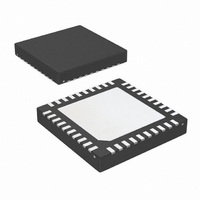LM2506SQX/NOPB National Semiconductor, LM2506SQX/NOPB Datasheet - Page 12

LM2506SQX/NOPB
Manufacturer Part Number
LM2506SQX/NOPB
Description
IC SER/DESER 18BIT MPL 40-LLP
Manufacturer
National Semiconductor
Series
LMr
Datasheet
1.LM2506GRNOPB.pdf
(19 pages)
Specifications of LM2506SQX/NOPB
Function
Serializer/Deserializer
Data Rate
320Mbps
Input Type
LVCMOS
Output Type
LVCMOS
Number Of Inputs
22
Number Of Outputs
3
Voltage - Supply
1.74 V ~ 3 V
Operating Temperature
-30°C ~ 85°C
Mounting Type
Surface Mount
Package / Case
40-LLP
Lead Free Status / RoHS Status
Lead free / RoHS Compliant
Other names
LM2506SQX
www.national.com
LM2506 Features and Operation
POWER SUPPLIES
The V
the same potential between 1.74V and 2.0V. V
the logic interface and may be powered between 1.74 and
3.0V to be compatible with a wide range of host and target
devices. On this device, V
before V
V
BYPASS RECOMMENDATIONS
Bypass capacitors should be placed near the power supply
pins of the device. Use high frequency ceramic (surface
mount recommended) 0.1 µF capacitors. A 2.2 to 4.7 µF
Tantalum capacitor is recommended near the SER V
for PLL bypass. Connect bypass capacitors with wide traces
and use dual or larger via to reduce resistance and induc-
tance of the feeds. Utilizing a thin spacing between power
and ground planes will provide good high frequency bypass
above the frequency range where most typical surface
mount capacitors are less effective. To gain the maximum
benefit from this, low inductance feed points are important.
Also, adjacent signal layers can be filled to create additional
capacitance. Minimize loops in the ground returns also for
improved signal fidelity and lowest emissions.
UNUSED/OPEN PINS
Unused inputs must be tied to the proper input level — do not
float them. Unused outputs should be left open to minimize
power dissipation.
PHASE-LOCKED LOOP
When the LM2506 is configured as a RGB Serializer, a PLL
is enabled to generate the serial link clock. The Phase-
locked loop system generates the serial data clock at 6X of
the input clock. The MC rate must be between 12 and 80
MHz (PCLKs from 2 to 13.3 MHz).
MASTER(SER)/SLAVE(DES) SELECTION
The M/S* pin is used to configure the device as either a SER
or DES device. When the M/S* pin is a Logic High, the
Serializer (SER) configuration is selected. The Driver block
is enabled for the MC line, and the MD lines. When the M/S*
pin is a Logic Low, the Deserializer (DES) configuration is
selected. The Receiver block is enabled for the MC line, and
the MD lines.
DDA
for proper device configuration.
DDcore
DDcore
and V
/V
DDA
DDA
(MPL and PLL) must be connected to
or at the same time as V
DDIO
should be powered up
DDIO
DDA
powers
DDcore
pin
/
12
POWER DOWN/OFF CONFIGURATION / OPTIONS AND
CLOCK STOP
Power Up Operation - Upon the application of power to the
LM2506, devices configured as a DES activate all outputs.
Outputs are held in deasserted states, with all zeros on the
data busses until valid data is received from the SER. If PD*
is asserted (Low) prior to the application of power, then the
part remains in its power down state.
On both the SER and the DES, the PD* pin resets the logic.
The PD* pins should be held low until the power supply
has ramped up and is stable and within specifications.
Power Down and the use of the PD* Input - When the PD*
signal is asserted low, the entire chip regardless of mode,
powers down. A Low on the PD* input pin will power down
the entire device and turn off the line current to MD0, MD1,
and MC. In this state the following outputs are driven to:
SER:
PD
DES:
DATAn = PCLK = Low,
VS = HS = DE = PE = Low
Multiple configurations for PowerDown are possible with the
chipset. These depend on the operating mode and configu-
ration chosen. Two possible applications are shown in Figure
14. RGB Modes are shown in (A) and (B). "A" provides PD*
input pins on both devices, this may be common or seperate.
In (B), the SER is controlled by the PCLK STOP feature and
a PDOUT* pin is provided to control the DES. When using
the SER PD
be the same to meet the PD* input thresholds of the DES.
The LM2506 provides a PCLK STOP feature on the SER
device. Gating of the pixel clock signal can be used to
generate a control signal for the SER to Power down or start
up. When a loss of pixel clock is detected (PLL out of lock),
the SER PD
down. When a PCLK is reapplied, the SER powers up, and
the PLL locks to the incoming clock signal. After 4,096 cycles
(t0), the SER MPL outputs are enabled and the DES is
calibrated. Once this is complete (t1 + t2 + t3), data trans-
mission can occur. See Figures 3, 4. The stopping of the
pixel clock should be done cleanly. Floating of the PCLK
input pin is not recommended.
OUT
= Low
OUT*
OUT*
mode, the V
pin is driven Low and the SER powers
DDIO
rails of the devices should










